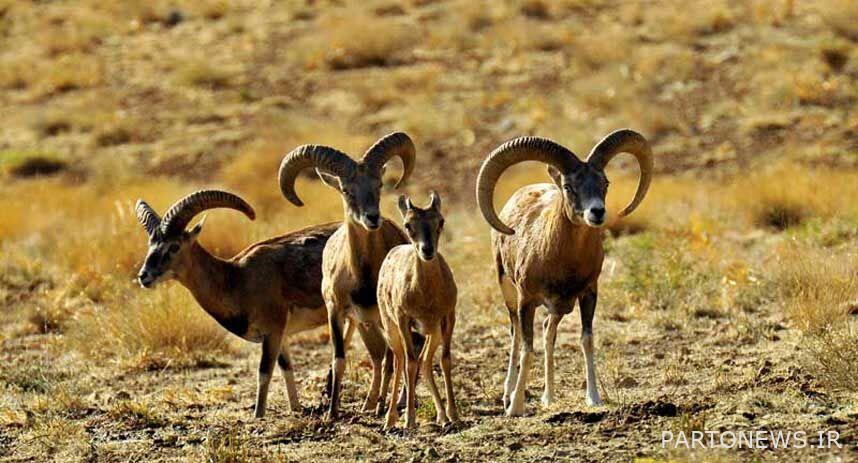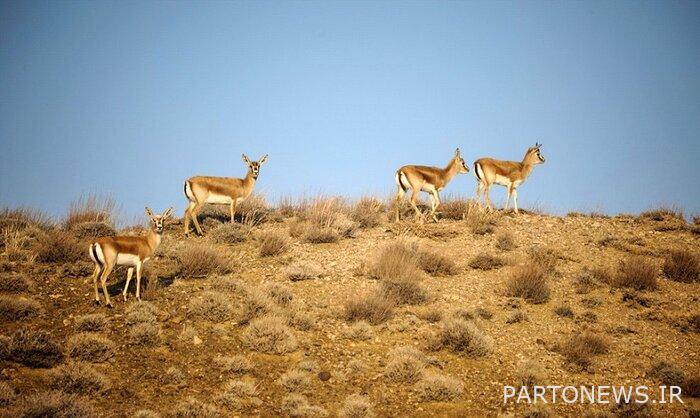Protected areas of Lorestan, a safe habitat for wildlife

Four Seasons Province of Lorestan with unique topographical conditions with an area of 171% of the country’s area has a very high biological diversity, so that this mountainous province is one of the unique shelters of diversity due to 35 peaks above 3,500 meters and climatic conditions. Biodiversity is considered at the level of the country and according to the studies of experts, due to the unique geographical indicators, more than 25% of the country’s biodiversity, including 368 animal species and 1,700 plant species, have been identified in it.
Preservation and protection of the environment in today’s societies is one of the indicators of sustainable development, which fortunately has been addressed in the past years, so that the size of the areas under the management of Lorestan has multiplied and the diversity of animal and plant species in these areas has increased. has been acceptable.
Lorestan, with an area equal to 28 thousand 306 square kilometers in the west of Iran, as one of the Zagros provinces, has had a significant growth and organization in the area of improving the level of areas under environmental management and even growing the population of rare species.
According to some experts, Lorestan, as a small Iran, experiences almost all types of weather in Iran in different seasons, which is the result of this variety of weather, plant and animal richness, and most species of the country are available in this province.
Lorestan has 2.2% of the population and 1.7% of the country’s area, and intermittent rains along with mountainous topography and suitable climate have created one of the most diverse plant ecosystems in this province, and these factors have created a network It is a river of the province with 30 permanent rivers with a length of 2,450 km in 2 basins, Dez and Karkheh.
Lorestan, being located between the Zagros mountain ranges, plays an important role in the ecosystem of this region and the country, so that out of the total 6 million hectares of Zagros forests, 1.2 million hectares are located in this province.
The river network of the province is one of the richest flowing water networks in the country, which, including the incoming water from the neighboring provinces after deducting the expenses, discharges more than 12.5 billion cubic meters of water into the lake behind the Dez and Karkheh dams, which is this volume. Water is about 11% of the total flowing water in the country.
On the other hand, the topography and mountainous conditions of Lorestan’s geographical situation and climate diversity are also one of the advantages of the biological diversity of this province, as the lowest altitude of the province is in Poldakhtar with 300 meters and the highest altitude is in Ashtrankoh with 4,800 meters above sea level. This issue has provided the basis for the presence of animal species, including leopards, as well as several endemic (unique) animal species in the province.
Some of the animal species of this province as umbrella species represent the very diverse biodiversity of this province, and on the other hand, animals such as Lorestan salamander, types of cats, Lorestan toad and three species of blind cave fish are species unique to this province.
150 animal species have been identified in Lorestan, of which five animal species, including the Lorestan toad, the Lorestan salamander and three species of blind cave fish, have been registered as endemic animal species in the world register.
Kel (mountain ranger), goat, wild boar, Persian leopard, brown bear, hyena, wolf, common fox, rabbit, teshi, wild cat, delijah, red-billed crow, vulture, long-legged sargepe, golden eagle, falcon, balaban, The well pigeon, all kinds of night owls, king owl, partridge, tiho, forest pigeon, moon pigeon, big risk wheel, gray eyed stone, kemmer kelli, keli keli small, chekauk are the most important animal species of this province.
Preservation and protection of Lorestan’s biodiversity is the priority of the Environment Agency
Technical Deputy of Lorestan Environmental Protection said: So far, more than 1,750 plant species have been identified, reported and recorded in the province, many of which are native, endemic and specific to the province, as well as 238 species of birds, 44 species of mammals, 55 species of reptiles. Five species of amphibians and about 20 species of fish have been identified and recorded in the river, wetland and mountain lakes of Lorestan.
Nabiullah Quaid Rahmat added: The country’s environmental organization and, accordingly, Lorestan’s environment always try to prevent the destruction and waste of natural resources and wildlife, to preserve examples of these divine gifts in a natural and pristine form for various uses. The future generations have been able to protect and support 11.37% of the total area of the province under the headings of natural-national heritage (Kur Mahi Cave), Sefidkoh Azna-Dorud and Salamanderal-Ristan Wildlife Sanctuary. Papi District Water Agency), register protected areas (Shtarankoh Protected Area, Sefid Koh Khoramabad, Qalikoh Aligudarz and Shadabkoh Poldakhter) and manage them directly according to the legal regulations.
Quaid Rahmat stated: Also, the necessary planning for the restoration of the habitats and ecosystems of the province was prioritized, and by sending specialized plans and proposals to improve and increase the protection level of the prohibited hunting areas (about 83.4 percent) to the relevant organization for In the course of the legal procedures, measures have been taken and if the submitted proposals are approved and registered, the level of areas under environmental management of the province will increase to 16.22%.
He said: Also, in this regard, the identity card of the areas under management and hunting and fishing areas of the province has been prepared.

There are 459 thousand 107 hectares of managed areas in Lorestan
Technical Deputy of Lorestan Environmental Protection said: Currently, 16 environmental protection checkpoints are active in Lorestan, and 2 checkpoints are under construction, and now the license for 2 more checkpoints has been obtained.
Quaid Rahmat added: Now there are 322 thousand and 114 hectares of four zones with an area of 11.37 hectares, 136 thousand and 993 hectares of prohibited hunting and fishing areas with an area of 4.38 hectares in this province, which are about 16% of the total area of the province.
He stated: In order to preserve and protect the animal species of this province, 12 smart cameras have been installed in the areas under the administration of the province, and in this context, Lorestan, as a pilot province, has started observing and monitoring important animal species using these cameras. .
He continued: Also, with the follow-ups carried out in the province, the yellow deer species has been brought into the province with the cooperation of the private sector, and soon after the reproduction, this rare species will be released in the nature of the province.
The Technical Vice President of Lorestan Environmental Protection stated that in the past, the Gazrede area of Lorestan was the path of the Yellow Deer’s Yalaq and Qeshlaq, and stated: Now, after the proliferation and increase of the population of this species of animal, efforts are being made in the field of tourism with the interaction of the private sector as a capacity. Considerable to be introduced in the province.
Referring to the efforts made in order to improve the areas under the management of the province, Quaid Rahmat said: Currently, the prohibited hunting areas of the province are 4.38% of the area of the province and the four areas are 11.37% of the area of this province, which is more than the national average. It is 11 percent.
He stated that hunting and fishing prohibited areas of the province have the ability to upgrade the level and added: Also, with the follow-ups, the White Azna Mountain Wildlife Sanctuary and a part of Ashtrankoh will be introduced as national parks.
Improving the management level of the four areas under environmental protection in Lorestan
Quaid Rahmat said: In recent years, 145 thousand hectares of the province’s natural areas have been upgraded to protected areas under the management of this organization, and now, in addition to the fact that 2 environmental protection posts are being built, permission has also been obtained to set up 2 more posts.
Technical Deputy of Lorestan Environmental Protection stated: These areas were upgraded to protected areas and wildlife refuges due to their biodiversity and habitat values.
He stated: Lorestani salamander habitats in Poldakhtar city under the title of Shadabkoh areas, Qalikoh fishing and hunting prohibited area in Aligoders city and Lorestani salamander habitats in the Papi section of Khorramabad city under the title of one salamander wildlife sanctuary (Ogen Water) in Tadbir government and Omid was added to the protected areas of the province.
Technical Deputy of Lorestan Environmental Protection stated: Currently, due to this increase in surface area, seven areas with an area of more than 322 thousand hectares, hunting and fishing areas are prohibited, 6 areas with an area equal to 1361 thousand 993 hectares, and 2 sensitive habitats with an area of Five thousand and 249 hectares are under environmental protection in Lorestan.
He continued: The size of the areas under environmental management has increased from 6.27% of the province’s area to 11.37%, which is a valuable, lasting and useful measure in order to preserve the biological diversity of the province.
Quaid Rahmat also continued: In order to improve the security factor in the areas under the administration of this province, the installation of camera traps in habitats and the recording of valuable images of wild animals such as the Iranian leopard, brown bear, and king fox have been implemented during the past years. has been
The increase in population and biodiversity of Lorestan’s wildlife in recent years
Technical deputy of Lorestan environmental protection also said: kel (mountain ranger), goat, wild pig, Persian leopard, brown bear, hyena, wolf, common fox, rabbit, tesh, wild cat, delijah, red-nosed crow, vulture, sargape pa The most important animal species of this province are long, golden eagle, falcon, balaban, well dove, all kinds of night owls, owl, partridge, tiho, forest pigeon, lunar, big risk wheel, gray eyed stone, keel keli, keli keli small, Chekauk. .
Referring to the actions of establishing special environmental branches in all Lorestan cities, canceling hunting licenses and confiscating the weapons of illegal hunters through the judicial system, he said: the state of biodiversity and wildlife population of this province has increased based on the census conducted. It is now unprecedented and very rich.
He continued: The discovery and identification of four new species of king fox, a new species of kurghar fish, hubreh and black-breasted gypsy rooster in the habitats of Lorestan is the result of extensive protection of the biodiversity of this province.
Quaid Rahmat stated: Every year, wildlife species, especially the key species, are enumerated in line with planning and how to make policies in the field of biodiversity.
He stated: The investigations carried out and the comparison of the census of the previous years show that the state of biodiversity and wildlife population of the province is very rich, which has been achieved due to protection measures, educational programs and decisive action against environmental offenders. Is.
He continued by emphasizing the need for Lorestan’s wildlife to meet international standards: the presence of large populations of rams, sheep, wild goats, large mammals and cats such as bears and leopards indicate rich biodiversity in protected and free areas. It is a province.
Technical Deputy of Lorestan Environmental Protection continued: More than 20 new habitats of the Lorestan salamander species have been identified in the province and 12 habitats have been registered, and continuous monitoring of the relevant habitats is on the agenda.
Before this, the Islamic Republic News Agency reported on the headlines that 12 wildlife monitoring cameras were installed in the protected areas of Lorestan, and the protected areas of Lorestan are the refuge of 25% of Iran’s biodiversity.


